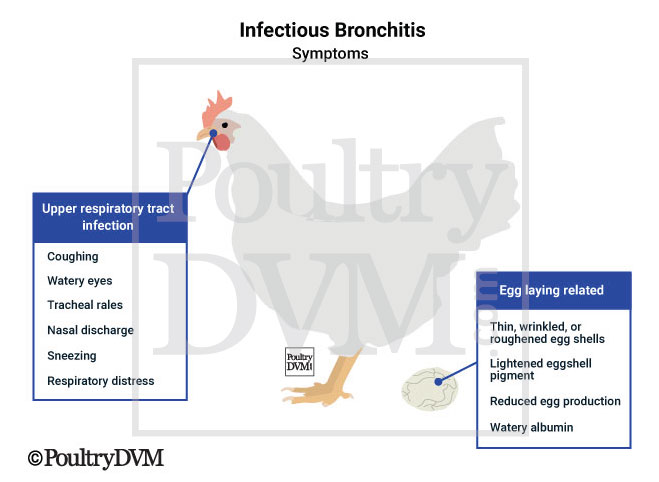Infectious bronchitis (IB) is an acute, highly contagious respiratory disease of chickens, caused by a coronavirus. There are several different serotypes and strains of the infectious bronchitis virus (IBV), which are found worldwide. The disease is associated with nasal discharge, coughing, rales, gasping and sneezing. Hens often lay less eggs than normal and produce abnormal eggs. Young birds are more severely affected by the virus then adult birds, and may develop severe respiratory distress.
Once infected, the virus initially replicates in the trachea, where it causes damage to the epithelium and predisposes the birds to secondary infections with pathogenic bacteria, especially E. coli and Mycoplasma. Depending on the strain of the virus, it may migrate from the trachea to other areas of the chicken's body, such as the kidneys, reproductive organs, or alimentary tract.
There are several vaccines available for prevention of the infectious bronchitis. However, since there are numerous different strains of the virus the vaccine is not always effective. Each vaccine targets a select number of virus serotypes, specific to each country. In North America, the three most common strains that affects the commercial poultry industry are the Massachusetts, Connecticut, and Arkansas 99 IB viruses.
Clinical signs
Clinical signs include watery or frothy exudate in the eyes, coughing, tracheal rales, nasal discharge, and sneezing. Young chicks who are more severely affected may appear depressed, huddling near a heat source, and develop severe respiratory distress.
When young female chicks are affected, it usually causes lasting damage to their reproductive system, and are prone to developing cystic oviducts once they start laying eggs. Adult hens often develop a sudden drop in egg production lasting for 10 to 14 days. They may also lay thin, wrinkled or roughened eggshells with thin, watery albumen. Loss of pigment in brown-shelled eggs is common.
Since the virus has a short incubation period, all birds within a flock develop clinical signs within 24 to 48 hours. The respiratory signs usually resolve within a week, unless the disease is complicated by co-infections with opportunistic bacteria.
Depending on the strain, the virus may cause damage to the bird’s kidneys and/or reproductive organs. If the infection spreads to the kidneys, it often leads to urolithiasis and renal failure. The virus may also cause damage to the bird’s reproductive organs (oviduct and ovary in hens, testes and epididymis in roosters).
Transmission
IB virus is acquired through inhalation or direct contact with infected birds or indirectly through exposure to a contaminated environment. Droplets containing the virus are expelled during coughing or sneezing, and shed in the feces or on the eggs, from infected birds. The virus is not transmittable from hen to chick through the egg. Once recovered, chickens may remain carriers and shed the virus for up to 15-20 weeks. IBV is easily destroyed by exposure to sunlight and common disinfectants.
Diagnosis
During the first week of infection, a trachea swab from the affected bird can be taken and sent to a veterinary diagnostic lab for confirmation of the IBV. After the first week, cloacal swabs are the preferred location. If the chicken has died, samples can be taken from the trachea, cecal tonsils, lung, kidney, testes or oviduct.
Prevention
There are several types of vaccines available against IBV, which are widely used by the commercial poultry industry. Laying hens and broiler breeders initially receive the live attenuated vaccine administered to young chicks en masse through sprays or via drinking water. Followed by the inactivated vaccine as a booster in 4-6 weeks.

